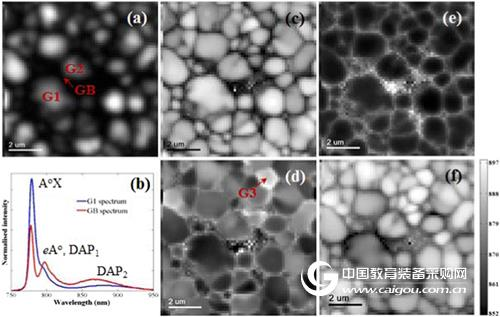CdTe thin-film solar cells have attracted wide attention from scientists due to their high energy efficiency. At present, confocal microscopic fluorescence spectra are often used to study the high conversion efficiency carrier mechanism of CdTe films. However, the time-resolved confocal microfluorescence method cannot fully assume that the long-life defect caused by the grain boundary of CdTe thin film is caused by the chlorine-doped passivation into a deep recombination level due to its micro-scale spatial resolution. Prof. Mendis from Durham University in the United Kingdom teamed up with the University of Liverpool to open up ideas and use the extremely high spatial resolution, energy resolution and time-resolved cathodoluminescence methods to characterize the transport of electrons and holes in the CdTe boundary and the long lifetime of holes in grain boundary defects. Binding behavior.

Fig.1 Cathodoluminescence spectrum of CdTe film at 12K temperature
Professor Mendis's research group used the Alalin Chronos 4027 system produced by Attolight in Switzerland to characterize the exciton at the grain boundary of the CdTe thin film and the defect luminescence behavior. The analysis system combines continuous cathode fluorescence spectrum acquisition and picosecond time-resolved cathode fluorescence spectrum acquisition with a minimum operating temperature of 4K and a spatial resolution better than 10 nm. The sample studied is a CdTe film prepared by magnetron sputtering. In theory, the material can achieve 28% photoelectric conversion efficiency, and has wide application in the field of solar cells.

Fig. 2 Time-resolved fluorescence spectrum obtained by pulse-excited CdTe film at 12K at low temperature, time integral of grain G1 and grain boundary GB
Fluorescence spectrum; b Neutral acceptor-bound exciton luminescence eA0 and c donor acceptor-to-jump luminescence lifetime
Professor Mendis used the Alalin Chronos 4027 system to detect the CdTe film grains by cathodoluminescence. The first mode was to obtain the hyperspectral data of the sample 128×128 pixels (Fig. 1a, each pixel at the image has spectral information) and corresponding Fluorescence spectra of grains and grain boundaries (Fig. 1b), the acceptor-bound exciton emission wavelength (A0X, Fig. 1c) is separated in the hyperspectral data of Fig. 1a; free electron acceptor defect luminescence (eA0Fig. 1d); donor The receiver is illuminated (DAP Figure 1e). It is analyzed that the acceptor defect is distributed more at the grain boundary of the sample. Switching to the pulse mode for further study, it is known that the grain boundary defect state has a longer fluorescence lifetime (Fig. 2), further illustrating the carrier dynamics between the grain boundaries in the CdTe film. (BG Mendis, Long Lifetime Hole Traps at Grain Boundaries in CdTe Thin-Film Photovoltaics, Phys. Rev. Lett. 2015, 115, 218701)
Dental Three Purpose Spray Gun
3 Way Syringe,Three Way Syringe,Dental 3 Way Syringe,3 Way Air Water Syringe
Henan Hanchen Medical Technology Co., LTD , https://www.hanchenyiliao.com
